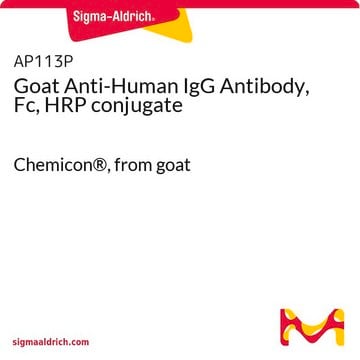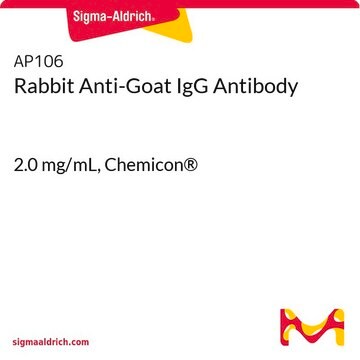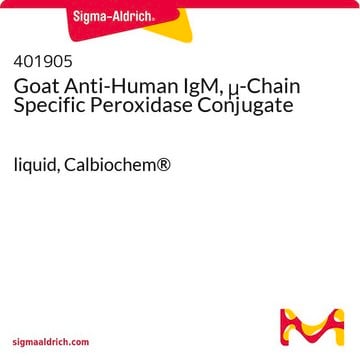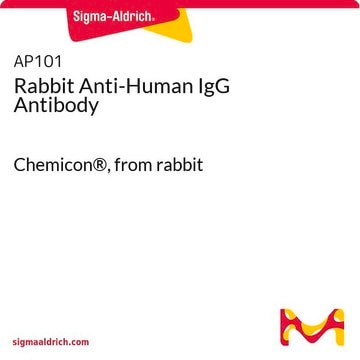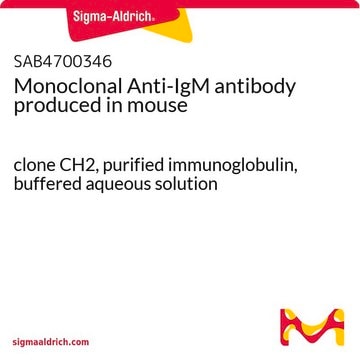MABX1901
Anti-human IgG (1mg) KC
from mouse
Autenticatiper visualizzare i prezzi riservati alla tua organizzazione & contrattuali
About This Item
Codice UNSPSC:
12352203
eCl@ss:
32160702
NACRES:
NA.41
Prodotti consigliati
Origine biologica
mouse
Forma dell’anticorpo
purified antibody
Tipo di anticorpo
secondary antibodies
Clone
monoclonal
Reattività contro le specie
human
tecniche
ELISA: suitable
immunodiffusion: suitable
Isotipo
IgG2b
Descrizione generale
Secondary antibody specific for Human Immunoglobulin G
Immunoglobulin G (IgG), an immunoglobulin isotype, is the most abundant protein in human serum and constitutes 10-20% of plasma protein. It is composed of glycoproteins comprising 82-96% of proteins and 4-18% of carbohydrates. IgG is further classified into IgG1, IgG2, IgG3, and IgG4 subclasses. IgG consists of four polypeptide chains, with two heavy chains (γ chains) and two light chains (κ or λ chains), which are linked by inter-chain disulfide bonds. It is secreted by B lymphocytes and found in extracellular fluids and blood.
Immunoglobulin G (IgG), an immunoglobulin isotype, is the most abundant protein in human serum and constitutes 10-20% of plasma protein. It is composed of glycoproteins comprising 82-96% of proteins and 4-18% of carbohydrates. IgG is further classified into IgG1, IgG2, IgG3, and IgG4 subclasses. IgG consists of four polypeptide chains, with two heavy chains (γ chains) and two light chains (κ or λ chains), which are linked by inter-chain disulfide bonds. It is secreted by B lymphocytes and found in extracellular fluids and blood.
Specificità
Specific for Human IgG. No cross reactivity with human IgA, IgD, IgE or IgE.
Immunogeno
corresponding to Human Serum IgG.
Applicazioni
Detect Human Serum IgG using this mouse monoclonal Anti-human IgG (1mg) KC, Cat. No. MABX1901-1KC, validated for use in Lateral Flow Assay and ELISA.
Azioni biochim/fisiol
Immunoglobulin G (IgG) primarily contributes to the humoral immune response by neutralizing pathogens such as bacteria, viruses, and protect cells from their toxic substances. IgG is the only isotype transferred to the fetus across the placenta and is vital for immune response of the neonate. Alterations in IgG fragment crystallizable (Fc)-glycosylation are associated with various diseases including rheumatoid arthritis and tuberculosis.
Qualità
Tested
Stato fisico
Format: Purified
Altre note
Concentration: Please refer to lot specific datasheet.
Not finding the right product?
Try our Motore di ricerca dei prodotti.
Codice della classe di stoccaggio
12 - Non Combustible Liquids
Classe di pericolosità dell'acqua (WGK)
WGK 2
Punto d’infiammabilità (°F)
Not applicable
Punto d’infiammabilità (°C)
Not applicable
Certificati d'analisi (COA)
Cerca il Certificati d'analisi (COA) digitando il numero di lotto/batch corrispondente. I numeri di lotto o di batch sono stampati sull'etichetta dei prodotti dopo la parola ‘Lotto’ o ‘Batch’.
Possiedi già questo prodotto?
I documenti relativi ai prodotti acquistati recentemente sono disponibili nell’Archivio dei documenti.
I clienti hanno visto anche
The N-glycosylation of mouse immunoglobulin G (IgG)-fragment crystallizable differs between IgG subclasses and strains.
de Haan N, et al.
Frontiers in immunology, 8, 608-608 (2017)
Noortje de Haan et al.
Frontiers in immunology, 8, 608-608 (2017-06-18)
N-linked glycosylation of the fragment crystallizable (Fc)-region of immunoglobulin G (IgG) is known to have a large influence on the activity of the antibody, an effect reported to be IgG subclass specific. This situation applies both to humans and mice.
Ratcliffe, M. J.
Encyclopedia of Immunology (2016)
Placental transfer of IgG subclasses in a Japanese population.
Hashira S, et al.
Pediatrics International, 42(4) (2000)
Gestur Vidarsson et al.
Frontiers in immunology, 5, 520-520 (2014-11-05)
Of the five immunoglobulin isotypes, immunoglobulin G (IgG) is most abundant in human serum. The four subclasses, IgG1, IgG2, IgG3, and IgG4, which are highly conserved, differ in their constant region, particularly in their hinges and upper CH2 domains. These
Il team dei nostri ricercatori vanta grande esperienza in tutte le aree della ricerca quali Life Science, scienza dei materiali, sintesi chimica, cromatografia, discipline analitiche, ecc..
Contatta l'Assistenza Tecnica.

